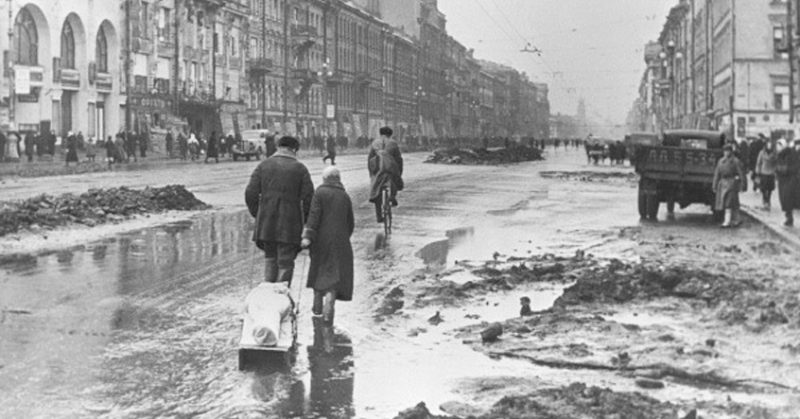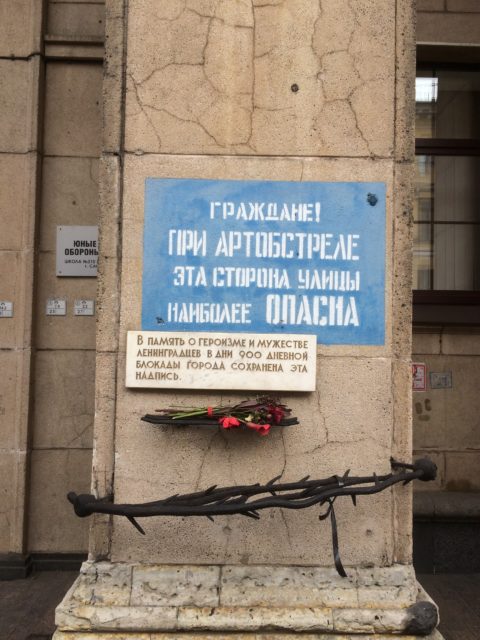Although many of us, after a hard day’s work complain of being ‘absolutely starved,’ how many of us have ever experienced starvation – real starvation?
Today millions throughout the world, face starvation caused by droughts, floods or wars, but few have experienced the horrors of being besieged with the intent of being quite literally starved to death. Such a horrific situation occurred in Leningrad during WWII.
Leningrad (now St. Petersburg), was a thriving industrial center and the USSR’s second-largest city. German armies, in June 1941, were ordered to target Leningrad, causing thousands of citizens to flee the city. By July the Moscow-Leningrad railway had been cut, and by September, the city was besieged.
Aerial bombardment and artillery fire destroyed much of Leningrad’s already limited stores of food and continued throughout the 872 days of the siege, often multiple times per day. This effectively destroyed utilities, causing disruptions of water and energy, but particularly of food supplies.
The result was severe starvation of the population, resulting in the deaths of over 1,500,000 persons before the siege was finally lifted.
The air attack of 19 September was probably the worst as the Germans used 276 of their bombers, resulting in more than a thousand civilian deaths.
Hospitals, shops, factories, schools, and essential infrastructure were destroyed. The air raids and long-range artillery bombardments increased in intensity, right through to 1943 when the shelling and bombing killed over 5,700 persons.
Leningrad was unprepared for the first winter of that war. The only way out of the besieged city was the “Road of Life,” (officially “Military Road No.101) across the frozen Lake Ladoga. Known as the Ice Road, it was dangerous, for vehicles got stuck in the snow or sank through the ice, and there was the constant danger of bombardment by the Germans.
Initially unusable, later it was the only way people could be evacuated and supplies brought into the city. A meager amount of military and food supplies got through, and thousands of residents, (mostly children, the elderly and the injured) were evacuated across the lake, but those left succumbed to starvation, bitter cold, and relentless air attacks.
Mass starvation had already begun during the first, dreadful winter of 1941. Ration cards were issued to the people and fairly soon bread had to be mixed with bran and cellulose and limited to 125g per day per person.
The people, weakened by lack of food and the cold weather, and desperate to keep themselves warm, began burning their pieces of furniture, their books and anything else they could find to use. By December, with temperatures of -40 degrees Fahrenheit, their suffering became even more intense.
The extreme hardships of cold and lack of food resulted in many persons being murdered – for their ration cards. More than 1200 such murders were recorded during the first six months of 1942. People had already had to eat the animals from the zoo, all the stray animals they could find, any birds they could snare and then eventually, their household pets.
Wallpaper was scraped for the potato paste used on it, window putty was chewed, leather was boiled to produce a type of gruel, grass and weeds were cooked. Finally, there was nothing at all left to eat and many absolutely desperate people were forced to resort to cannibalism to stay alive.
A survivor of the siege of Leningrad, the Russian author Daniil Granin, tells that cannibalism was not uncommon during that time. He noted that the authorities tried their best to put a stop to the eating of people, carrying out prompt executions of anyone found guilty of such action, with no appeals being allowed.
By the December of 1942 over 2,100 cannibals had been arrested, of whom many were actually murderers, having first killed their victims before eating them. For us, fed, warm and safe, it is inconceivable that such dreadful atrocities took place.
Can we, however, imagine experiencing the absolute desperation of starvation, coupled with debilitating cold and the fear of bombardment, which together resulted in over 100,000 deaths per month?
The people of Leningrad showed great fortitude, for, in the midst of this terrible struggle for survival, there were many examples of people trying to live as normal a life as was possible. In the first winter of the siege, studies continued, for about 2,500 students graduated from the University.
Theatre performances were held, the museums were open and in the summer of 1942, Dmitri Schostakowitsch premiered his seventh symphony which had apparently been written the year before, while the city was constantly under fire.
In January 1943, Red Army soldiers broke through the German line and managed to create a more efficient supply route along the shores of Lake Ladoga. The “road of life” helped to ease the dreadful existence of those in Leningrad.
That summer, the citizens were able to plant vegetables within the besieged city, which supplemented their meager rations and thus provided some relief. It took a further year of deprivations, though, before 27 January 1944, when the Soviets finally overcome the German forces and the 872 day- siege was finally ended, DW.com reported.
Historians are of the opinion that the siege of Leningrad was the most lethal in world history, for the destruction and the loss of human life, they feel, was more than even that of the atomic bombing of Hiroshima – which is a most sobering thought.


